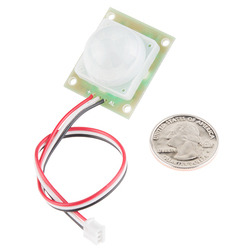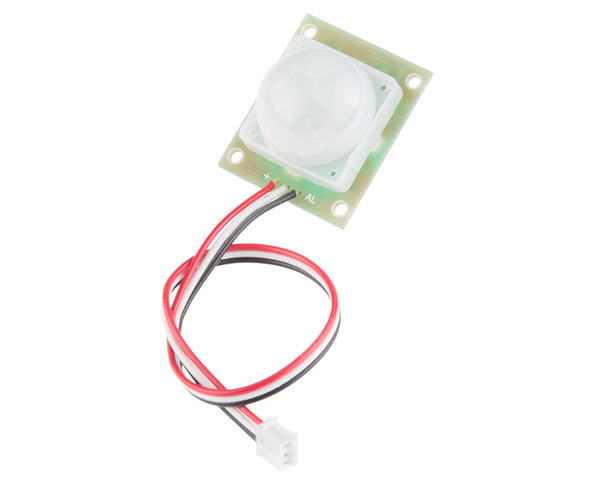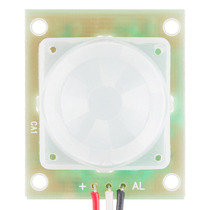PIR Motion Sensor
The passive infrared (PIR) motion sensor detects movement of infrared light sources with wavelengths ranging from 7 μm to 14 μm. Since people emit infrared radiation from 8 μm to 14 μm, this an excellent sensor for detecting human movement. Two infrared detector “pixels” allow the detector to filter out changes affecting the whole sensing area, like weather or light.
| Description | Specs (1) | Pictures (4) | Resources (1) | FAQs (0) | On the blog (0) | Distributors (0) |
|---|
 |
PIR motion sensor with quarter for size reference. |
|---|
Overview
The passive infrared detector senses motion of infrared light sources at the same wavelengths humans emit. Passive infrared detectors like this one are used in security and automation applications. In security, motion sensors are integrated into alarm systems and used to turn on security cameras. PIR motion sensors are also used to automatically turn on lights when people enter a room.
The two pyroelectric sensing elements allow the PIR motion sensor to see moving infrared light sources while ignoring changes in background infrared radiation. A lens focuses the infrared light on to the two silicon-coated sensing elements.
 |
PIR motion sensor with the lens removed, revealing the sensing elements beneath. |
|---|
When the sensor is powered on, it takes 1 to 2 seconds to calibrate itself to the background infrared radiation before it can detect motion. After calibration, the detector drives the open-collector Alarm pin low for the duration of the sensed motion (the alarm pin state is not latched); when there is no motion detected, the alarm pin is floating. The open-collector setup allows multiple motion sensors to be connected on a single input pin, but it means that you will need an external pull-up resistor on the alarm pin. If any of the motion sensors go off, the input pin will be pulled low.
We expect this PIR motion sensor to be functionally the same as our older version; the only thing that changed is the connector, which is now a 3-pin female JST PH-style connector. This connector has a 2 mm pitch and is not compatible with 0.1″-spaced connectors. For use with common 0.1″-spaced connectors or breadboards, you might consider cutting off the JST connector and splicing on a connector of your choice.
|
|
Connections
Note: The cable wire colors can vary. Referring to the top-view picture above, the left-most wire is power, the middle wire is the ground, and the right-most wire is alarm.
This sensor should be powered at 12 V; our U3V12VF12 12V boost regulator and S10V2F12 12V step-up/step-down regulator are good options for powering this sensor from input voltages other than 12 V. The signal is an open-collector output, which requires an external pull-up resistor.
Note: SparkFun calls this product the “PIR Motion Sensor (JST)” SKU: SEN-13285. It replaces the older Passive Infrared (PIR) Detector SE-10.
People often buy this product together with:
 |
Mini Maestro 12-Channel USB Servo Controller (Assembled) |
 |
0.1" (2.54mm) Crimp Connector Housing: 1x3-Pin 25-Pack |












